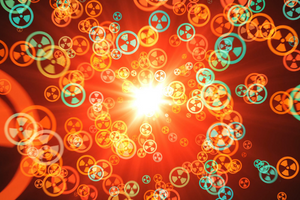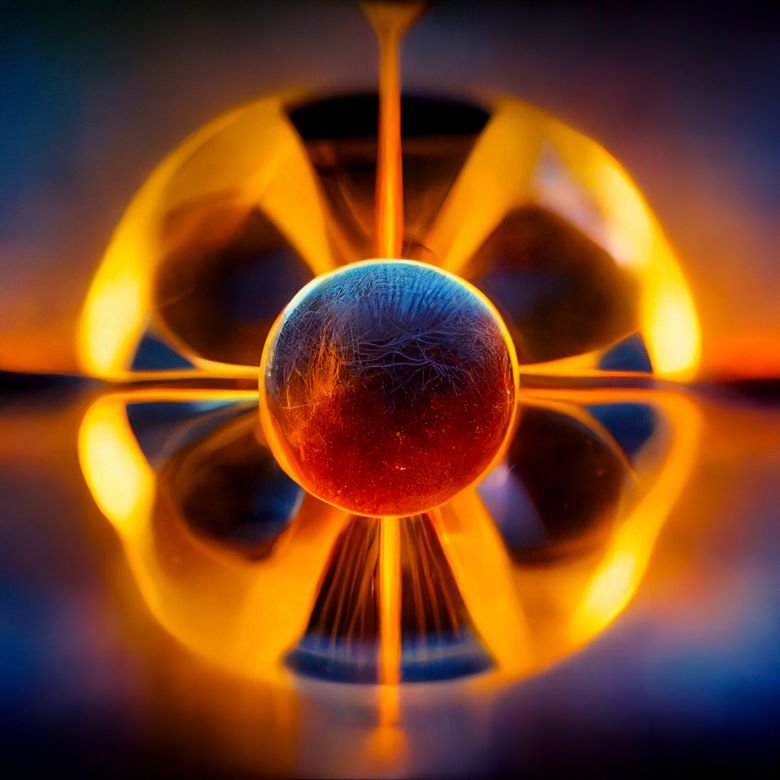The transformations occurring in atomic nuclei, which are the result of transition into an energy state other than the lowest possible, are referred to as nuclear disintegration. The formation of such low-stability nuclei may result not only from laboratory conditions but also from changes occurring naturally. That subtype of unstable nuclei is called radioactive nuclei. The disintegrations occurring within that group are referred to as radioactive disintegrations. What exactly is characteristic of the radioactive disintegration of elements? You will learn that from this text.

The structure of the universe Radioactive disintegration in the context of the structure of the universe
The shaping of the universe led to the formation of several elements that are predisposed to nuclear transformations. Each radioactive disintegration that we can describe is able to give us a lot of information on topics closely related to a particular nucleus (its structure, existing energy states, and interactions), but also provides information about the origin of the universe. It has been empirically proven that there are three principal types of radiation, which are divided by the ability to penetrate through matter:
- Alpha (α) radiation, which has the form of helium nuclei and shows low permeability, that in practice means difficulty to penetrate a thin sheet of paper;
- Beta (β) radiation, which is described as electrons or positrons with the same mass but an opposite charge, is able to penetrate into aluminium up to approx. 3 mm;
- Gamma (γ) radiation, which corresponds to photons, has the best penetration ability that is comparable to the penetration into lead up to two or more centimetres.
History of radioactive disintegrations
The history of radioactive disintegrations was initiated by Antoine Becquerel, who observed in 1896 that if we put an uranium-rich rock into an enclosed box with a photographic film, the film will get dark. He concluded that this was caused by the emission of rays that are invisible to the naked eye. With today’s knowledge, we can give at least three arguments suggesting the nuclear origin of such rays:
- Chemical state: the form of a particular element in a free state or in a chemical compound does not affect its radioactive ability;
- External factors affecting the electrons in the atom, such as pressure or temperature, do not affect the radioactive properties;
- The commonly known electron transitions in the atom do not generate such huge amounts of energy that can reach millions of electronvolts.
Today, radiation is defined as processes of nuclear nature which change mass into energy.

Alpha, beta and gamma radiation
The electrical properties of radiation can be observed thanks to their motions occurring in a homogeneous magnetic field. The identification of each type of radiation with their corresponding molecules is based on the formula for the Lorentz magnetic force.
Assuming a horizontal emission from the point of a radioactive source, the particles with a positive charge are inclined upwards, those with a negative charge are inclined downwards, and the particles with no charge penetrate through the magnetic field, not affecting the path of emission. Alpha radiation corresponds to the emission of a 4He helium nucleus. Beta radiation may occur in two ways: in the form of electrons (β–) or positrons (β+). Gamma radiation determines a high-energy emission of photons.
Alpha disintegration
It is characterised by weight and chemically unstable nuclei. During disintegration, the nucleus loses two protons and the same number of neutrons, which implies the reduction of its atomic number by two and the mass number by four units. The result of that transformation is a helium atom. The emitting nucleus is called the primary nucleus, and the one produced during disintegration is called the secondary nucleus. The basic notation of alpha radioactive disintegration can be presented as follows:

The first part of such a notation, i.e. , constitutes the primary nucleus, the secondary nucleus is , while is the alpha particle.
An example of alpha disintegration can be a transformation of the uranium isotope 238U, during which the atomic number is reduced by two. The disintegration can be noted as the following equation:

The energy released during alpha disintegration is equal to the kinetic energy of the nuclei of helium and thorium. Due to the mass of thorium nuclei, and thus their lower speed, the kinetic energy of helium nuclei is higher.
Beta disintegration
This may occur in two ways: with the emission of electrons or positrons. Their charges are opposite but their mass is identical, so sometimes a positron may be referred to as antielectron. When considering the beta radioactive disintegration, scientists usually used the model of a molecule (an electron or positron) bounded in the nucleus, which escapes from it during disintegration. This assumption has been challenged, as based on Heisenberg’s uncertainty principle the kinetic energy of an electron was estimated to be a little more than ten GeV. However, it has been proven empirically that it is equal to only a few megaelectronovolts. This means that the beta disintegration consists not in the escape of a molecule but in the transformation of one nucleon into another. When analysing the disintegration of a neutron, we can observe the following transition:

The electron, noted as , has a mass number equal to 0 and an atomic number. This means that it is a virtually massless molecule with a negative charge. The proton has both numbers equal to one. The presence of a neutrino (v) is required given the laws of conservation of energy and momentum. Such transformations occurring in the nucleus cause weak nuclear interactions. An example of an isotope subject to beta disintegration is the , which disintegrates by a β– emission according to the following equation:

An opposite process, involving the production of a positron, occurs for example in an isotope of aluminium :

Gamma disintegration
The term “gamma disintegration” refers to a disintegration that occurs when an excited nucleus turns to a state with a lower energy, which results in the emission of photons. Such a transition is similar to the transition of electrons to lower energy levels and can be noted with symbols, where * stands for the excited state :

The mass and atomic numbers do not change during gamma disintegration. The only change refers to the type of nucleus.

Radioactive elements
Their atoms disintegrate spontaneously, emitting particles or rays. This is often accompanied by the emission of heat and light. In nature, we can observe four groups of radioactive elements: thorides, neptunides, uranides and actinides, whose names derive from the parent elements. Examples include:
- Polonium – a product of atomic disintegrations, mostly involving uranium-238. It is a source of alpha radiation and it is used as the source of energy in satellites.
- Radon – produced as a result of disintegration of radium, whose isotope with an atomic mass of 222 is used in treating serious cases of cancer.
The radioactive series
It is considered that all nuclei with an atomic number higher than 82 are unstable and subject to spontaneous disintegration. Most of them are also characterised by a short life cycle, so they are not observed in nature. However, there are a few important exceptions, such as and , whose half-life period is 1.39·1010 years and 7.04·108 years, respectively. The decay of heavy nuclei can lead to a long series of disintegrations, as each secondary nucleus produced may become the primary nucleus in a subsequent disintegration, until a stable nucleus is formed. This process is called the radioactive series.